Bottom-feeding fish are excellent both as a single species and to add interest to the lower levels of the water column.
Before deciding on one for your freshwater aquarium, consider the following that apply generally to these types of fish.
In this article
Substrate, Decorations, and Lighting

Bottom feeders spend a good portion of their time, if not all of it, on the bottom of the tank.
As such, consider the species’ habits when selecting a substrate. Color, grain size, and even the amount you lay down can vary depending on the species.
Because some species are shy and others are nocturnal, make sure there are plenty of hiding spaces and keep the lighting dim.
Water Conditions
Ensure that the bottom of the water column is well oxygenated. Current, bubblers, under gravel filtration systems, or a canister filter can help keep the water from becoming depleted.
Feeding

Bottom-dwelling species like to sift through the substrate for uneaten food. Some have sensory adaptations, such as whisker-like structures, to aid in their search.
Although they constantly scour the tank, each will need supplemented food to round out their diet.
In a community tank, make sure that your bottom feeders are well fed. Greedy middle to top dwellers can quickly grab all the food as it floats down, leaving little for their bottom-dwelling friends.
Sinking pellets, wafers, or tablets are a good solution, just make sure they are appropriately sized.
Likewise, spot feeding or clipping foods near the tank floor can help. For nocturnal species, feed them after the lights are out.
Finally, algae eaters need a robust layer of mature algae, so add objects such as live plants and driftwood that can encourage algae growth.
Tank Mates

Most bottom dwellers are peaceful. Pair them with fish species having similar temperaments.
Research online or contact local fish stores to determine whether the species you select needs more of its own kind to display active behaviors.
Our Favorite Bottom Feeders
The following are some of our top choices for bottom-dwelling additions to your tank.
1. Rosy Loach (Petruichthys sp. ‘Rosy’)
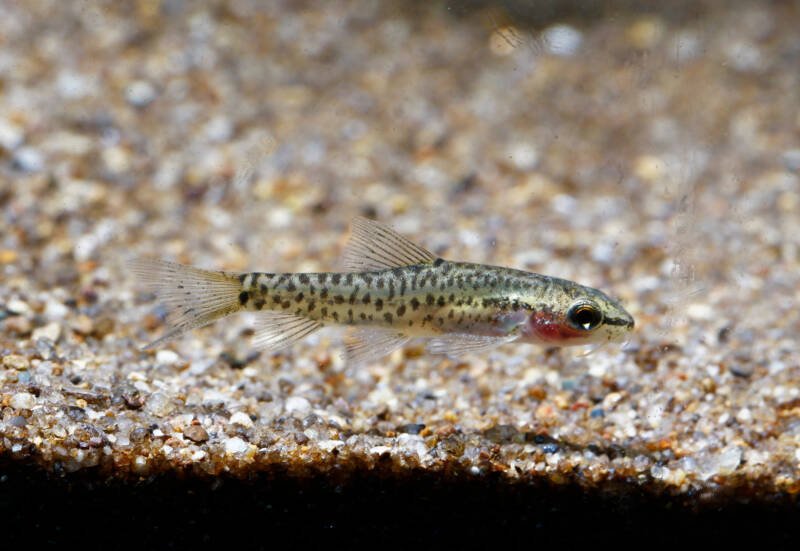
- Difficulty: Easy
- Temperament: Peaceful
- Diet: Omnivore
- Tank Size: 6 gal (23 l)
This loach is highly social and active in a group of five or more.
They are ideal for both nano and community tanks, but at a tiny adult size of 1.3 inches (3 cm), take care when selecting tank mates.
Rosy loaches are micro-predators that need a mix of foods and will readily accept a variety.
They are active and metabolize this food quickly, so feed them multiple times each day. Foods should be appropriately sized for a small mouth.
These fish come from shallow, heavily vegetated waters and do well in a lush tank.
They are hardy but susceptible to swings in water parameters, especially those that occur in small tanks.
2. Amano Shrimp (Caridina multidentate)

- Difficulty: Easy
- Temperament: Peaceful
- Diet: Omnivore
- Tank Size: 10 gal (38 l)
If you are looking for a cleanup crew member that can handle course substrate, the Amano shrimp is perfect. They will comb the tank bottom and extract food from small spaces.
They eat several varieties of annoying algae and are efficient cleaners. Plus, their low bioload means they will not alter the water parameters with their constant snacking.
Always introduce Amano shrimp to a well-established tank. They are extremely sensitive to fluctuations in tank conditions.
Provide plenty of hiding places and avoid fish foods or medications containing copper.
Carefully select tank mates to ensure the species do not consider your Amano shrimp as prey. These shrimp can live with larger, peaceful ornamental fish.
3. Dwarf Chain Loach (Ambastaia sidthimunki)

- Difficulty: Moderate
- Temperament: Semi-aggressive
- Diet: Omnivore
- Tank Size: 30 gal (114 l)
The dwarf chain loach has a lovely black/gold pattern resembling interlinking chains. This dwarf species is a manageable two to 2.5 inches (5 to 6.4 cm) fully grown.
While they can survive in a smaller tank, a larger aquarium will reduce their aggression.
They do not sсhool but are most confident with others of their kind. A group of at least six fish is good, and more is better. They will peck at each other a little to establish a hierarchy.
Another long-lived loach, they average eight to 12 years with excellent care. If you are looking for a fish to keep pest snails under control, this is your fish.
4. Corydoras (genus)
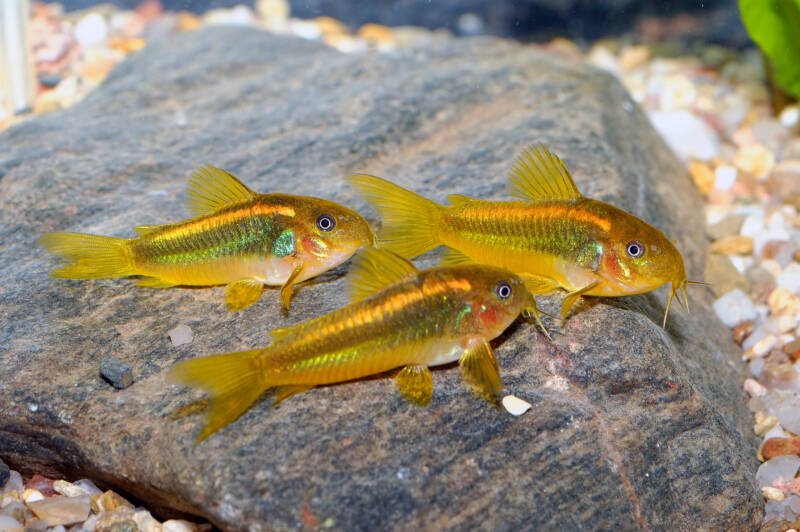
- Difficulty: Easy
- Temperament: Peaceful
- Diet: Omnivore
- Tank Size: 20 gal (76 l)
The peaceful cory keeps to itself and gets along splendidly with fish that are larger or smaller than it is, giving you incredible flexibility in selecting tank mates.
They stay small, reaching one to four inches (2.5 to 10 cm) as adults.
The size depends on which of over 170 species you select! Check out the salt and pepper, bandit, panda, pygmy, and speckled varieties if you are looking for smaller species.
Corys come from oxygen-low waters and are adapted to gulp oxygen from the surface. In an aquarium, you will see them pop to the surface every now and then.
Most of the time, they will be at the bottom of the tank, endlessly searching for food.
5. Hillstream Loach (Sewellia lineolate)
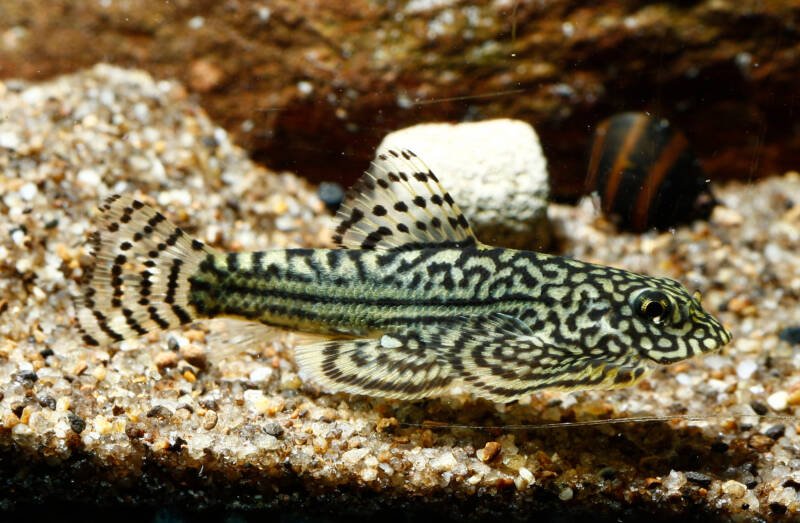
- Difficulty: Easy
- Temperament: Peaceful
- Diet: Omnivore
- Tank Size: 50 gal (189 l)
These fish are highly adapted to their native, fast-moving streams.
Their tapered bodies and flat, streamlined fins accent their hydrodynamic form, making them look like little stingrays. Their dappled pattern is perfect for camouflaging on the substrate.
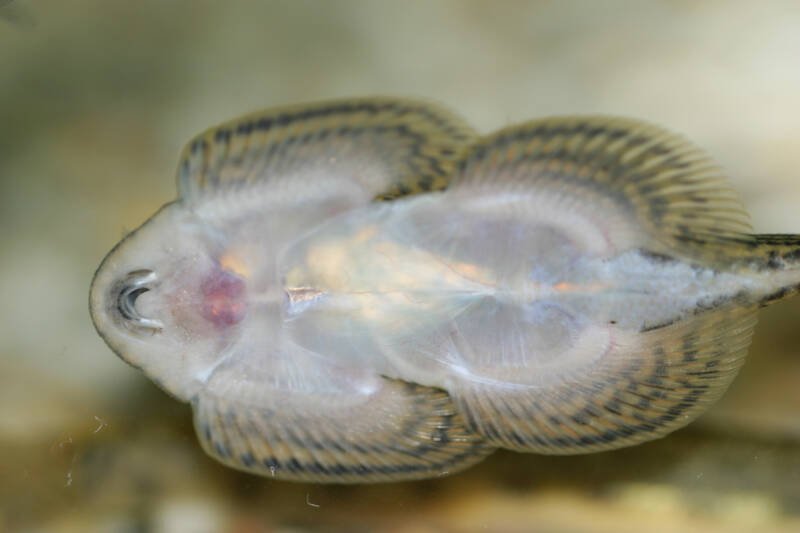
Although they grow to an average of 2.5 inches (6.4 cm) in length, they need a group of three to four and a larger tank to provide an oxygen-rich environment and strong current. Smaller groups or tank sizes lead to territorial aggression.
Hillstream loaches favor cooler waters, so keep that in mind when selecting tank mates and pair them with fish that tolerate the same conditions.
6. Crayfish (Cambarus sp.)
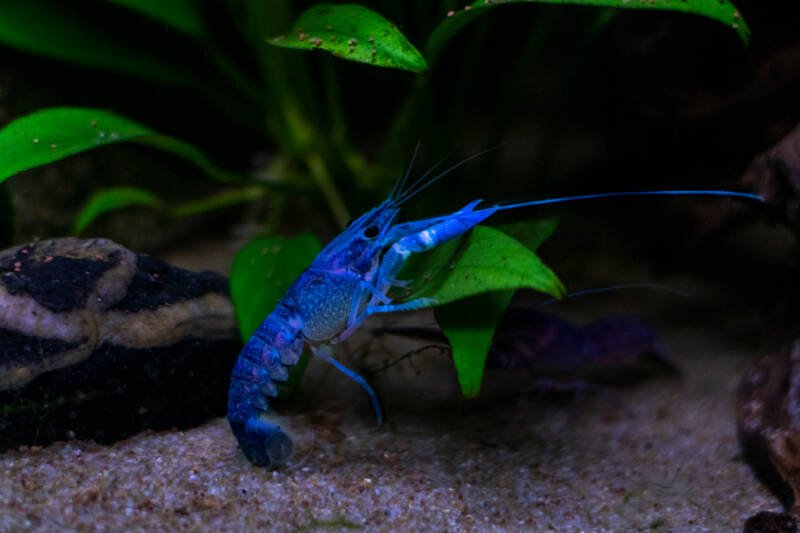
- Difficulty: Easy
- Temperament: Aggressive
- Diet: Omnivore
- Tank Size: 10 gal (38 l)
Crayfish are hardy and easy to care for. There are numerous species from which to choose, providing an immense range of colors and patterns.
Avoid housing them with peaceful bottom dwellers, as your crayfish may become aggressive toward them, and even toward their own kind. Select sturdy fish that occupy the middle to upper levels.
At a reasonable adult size of three to four inches (7.6 to 10 cm), crayfish tank size is not challenging for the beginning aquarist. Keep the water well oxygenated and the lid on tight.
This species frequently molts, so make sure your tank has plenty of hiding spaces while their new shell hardens.
7. Pictus Catfish (Pimelodus pictus)

- Difficulty: Moderate
- Temperament: Peaceful
- Diet: Omnivore
- Tank Size: 55 gal (208 l)
The pictus catfish is a lovely silver color accented all over with black dots.
They are curious, active fish that learn to be brave during the daylight hours once they are comfortable in the tank. Some floating plants, rocks, and dim lighting will encourage this behavior.
These fish are easygoing but will eat smaller species if given the chance. They reach an adult length between four and five inches (10 to 13 cm) and have serrated pectoral fins.
Happily kept as a single specimen or in a group, the pictus catfish pairs well with fish of comparable size.
Avoid territorial bottom dwellers as well as species that cannot tolerate the pictus’ activity levels.
8. Siamese Algae Eater (Crossocheilus oblongus)
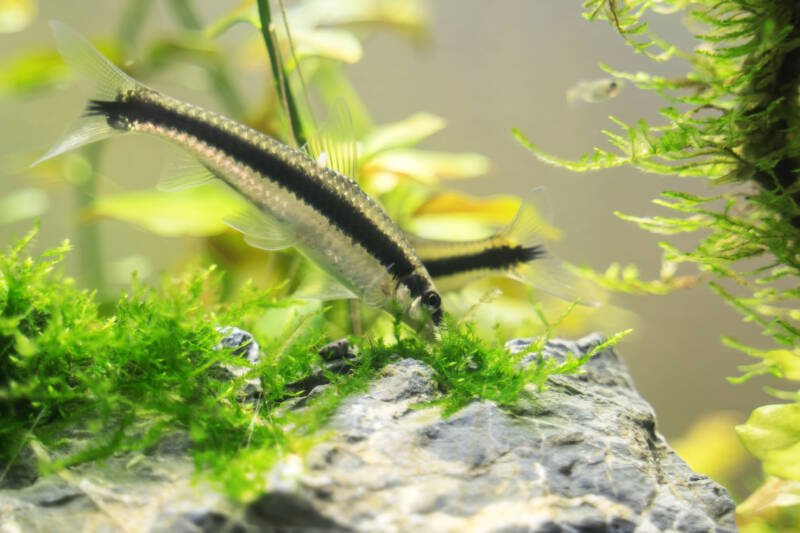
- Difficulty: Easy
- Temperament: Peaceful
- Diet: Omnivore, with a focus on algae
- Tank Size: 30 gal (114 l)
The Siamese algae eater is the top algae consumer in an aquarium setting. They feast on a range of algae types, including those difficult to remove.
They are content to live as a single specimen or in larger groups. Limited group sizes of three or four fish may result in territorial aggression.
These fish favor a narrow range of warm water temperatures but make up for it with a wide pH range, opening up the list of potential tank mates.
Their six-inch (15 cm) adult length means a larger tank size to provide them adequate floor space. Add a tight-fitting lid to keep these jumpers contained.
9. Yo-yo Loach (Botia almorhae)
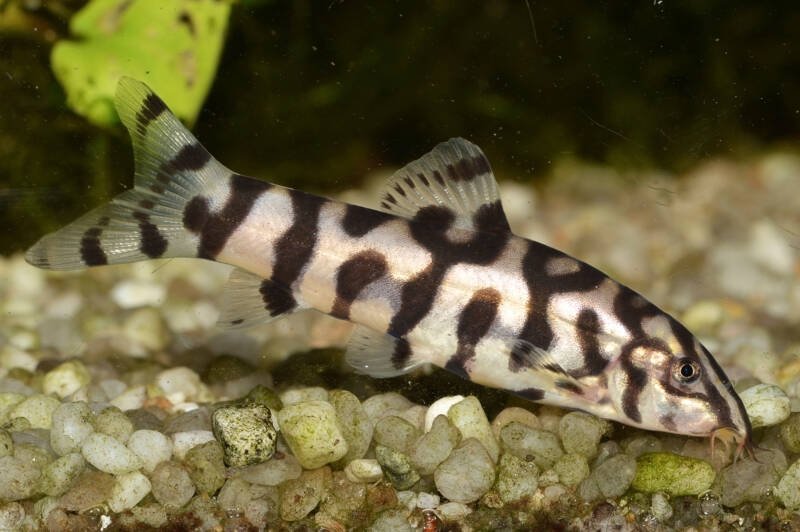
- Difficulty: Easy
- Temperament: Peaceful
- Diet: Omnivore
- Tank Size: 40 gal (151 l) for a single fish, add 15 gal for each additional loach
The yo-yo loach is quite a find. Their name either comes from the resemblance of the squiggles on their back to the letters “Y” and “O” or due to their habit of “bouncing” up and down in the water column. Either way, this fish is fun to watch!
Most only reach a tiny 2.5 inches (6.4cm) in captivity, although they can grow up to six (15 cm).
The minimum group size for yo-yo loaches is five. Any smaller group will result in the weakest loach being picked on.
They are hardy fish but have small scales, meaning they are the first to contract any of the typical tank ailments. Take care to not overfeed this voracious species.
10. Red Tail Shark (Epalzeorhynchos bicolor)

- Difficulty: Moderate
- Temperament: Semi-aggressive
- Diet: Omnivore
- Tank Size: 55 gal (208 l)
The red tail shark is easy to spot with its all-black body and bright red tail fin.
Red tail shark care begins with a well-sized tank and adequate nutrition (smaller tanks lead to territorial aggression).
Avoid housing them with similar-looking fish, such as the rainbow shark. They are easy to feed and undemanding in their tank requirements and water parameters.
Red tails bring high activity to the bottom level of the tank and are best paired with fish that stick to the upper levels.
These fish are critically endangered in the wild, so consider your level of commitment before purchasing one and only buy from a reputable seller.
11. Otos (Otocinclus genus)

- Difficulty: Easy
- Temperament: Peaceful
- Diet: Herbivore
- Tank Size: 10 gal (38 l)
There are 19 species of this “dwarf” suckerfish from which to choose. They are efficient algae consumers and help significantly with tank cleanliness.
Depending on the species you choose, these fish range in size from one to two inches (2.5 to 5 cm).
While otocinclus will happily devour the algae in your tank, you should also offer algae wafers or small-sized vegetables to supplement.
In the wild, they travel in groups, so plan to keep four to six specimens in your tank. They easily pair with other peaceful fish that occupy the middle to upper levels of the water column.
12. Bristlenose Pleco (Ancistrus cirrhosus)
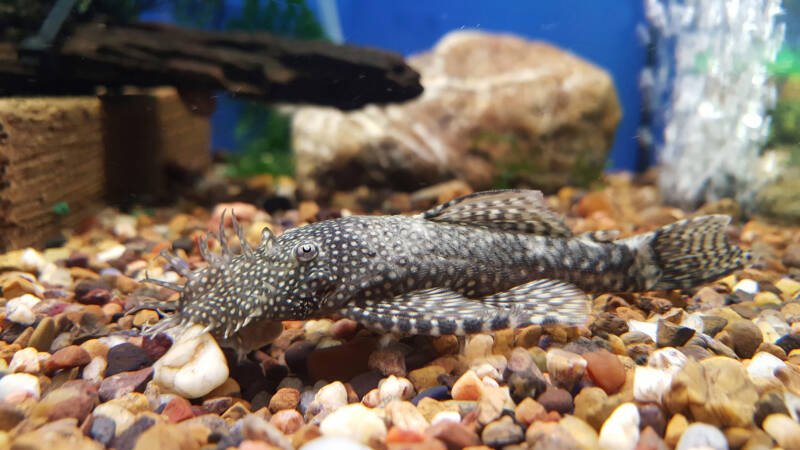
- Difficulty: Easy
- Temperament: Peaceful
- Diet: Omnivore, with a focus on algae and vegetables
- Tank Size: 25 gal (95 l)
Easily recognized by the mass of appendages on the front of its face, the bristlenose pleco is interestingly cute.
With spiny fins and bony plates, they are well-armored, grow to a length of three to five inches (8 to 13 cm), and come in a range of colors and patterns.
Bristlenoses are excellent scavengers. Algae is their first food choice, but they need supplementation with algae wafers, spirulina pellets, and the occasional meaty treat, such as brine shrimp.
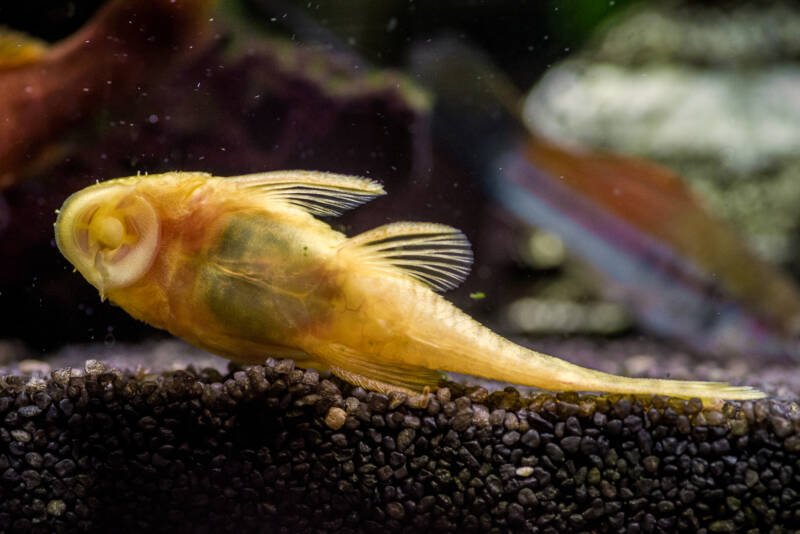
They average a five-year lifespan in captivity, but with excellent care, you can push that limit toward 12 years.
These fish tolerate a massive range of water temperatures and can thrive in a cold-water fish tank.
13. Cherry Shrimp (Neocaridina davidi)

- Difficulty: Easy
- Temperament: Peaceful
- Diet: Omnivore
- Tank Size: 5 gal (19 l)
Cherry shrimp bring a pop of red color, which stands out nicely in a well-planted tank. These selectively bred shrimp come in a range of color grades and prices.
Cherry shrimp are active during the daytime, which makes them fun to watch.
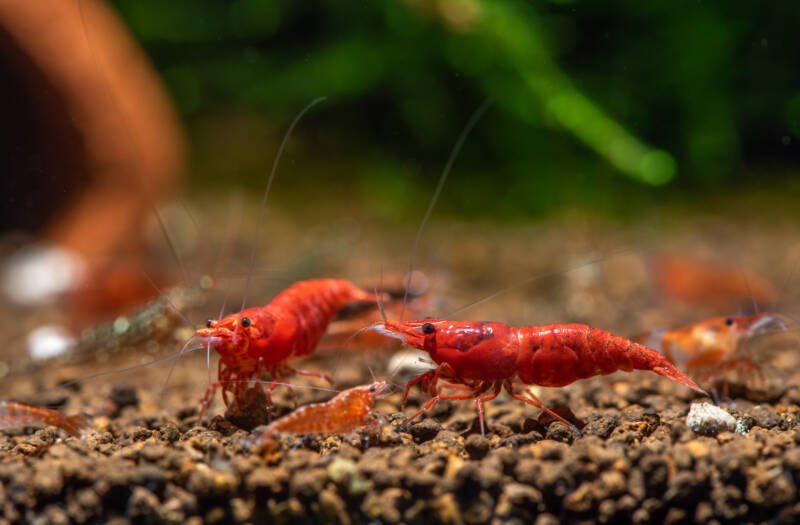
They are more comfortable when kept in a large group. Think ten or more shrimp in a mature tank with plenty of places for them to hide.
They stay between 0.8 and 1.5 inches (2 to 3.8 cm) in length and are great for nano tanks.
They have no natural defense mechanism and so are best kept in a single species tank or with small, peaceful fish.
14. Mystery Snails (Pomacea brigesii)

- Difficulty: Easy
- Temperament: Peaceful
- Diet: Omnivore
- Tank Size: 10 gal (38 l)
These popular aquarium snails frequently go by the name of apple snail. There are multiple Pomacea species that fall under this name; however, all except the P. brigesii are restricted.
They are gentle in temperament, adept at cleaning algae from multiple tank surfaces, and will not harm aquatic plants.
Mystery snails are 1.7 to 2.5 inches (4 to 6.4 cm) fully grown, so tank size is manageable for keepers with limited space. Their temperament makes them suitable to pair both with peaceful fish and invertebrates.
Incredibly hardy, they even have gills for aquatic respiration and a specialized breathing tube to extract oxygen from the water’s surface.
15. Bamboo Shrimp (Atyopsis moluccensis)

- Difficulty: Easy
- Temperament: Peaceful
- Diet: Omnivore
- Tank Size: 10 gal (38 l)
You may see the bamboo shrimp listed under the common names of fan shrimp, wood shrimp, and filter shrimp.
Their most striking features are the silky, fan-like structures on their forward legs. The shrimp use these four pairs of fans to filter food from the water and bring it to their mouth.
These are larger shrimp, maxing out between three and four inches (7.6 to 10 cm) in length. With that size, however, comes a peaceful temperament and the ability to coexist in a community tank.
The bamboo shrimp loves a strong water current and should not be housed in a nano tank. Pair them with other species that favor the same conditions.
16. Ghost Shrimp (Palaemonetes paludosus)

- Difficulty: Easy
- Temperament: Peaceful
- Diet: Omnivore
- Tank Size: 5 gal (19 l)
The popular ghost shrimp is inexpensive, hardy, and active. Add to these the shrimp’s effectiveness at tank cleanup and ease of care, and you have the perfect beginner shrimp.
This translucent species tolerates an incredible range of water temperatures and pH levels; however, as with most shrimp, stable conditions are best.
They are excellent for nano tanks, where they will thrive in a species-only environment. Other tank mates may consider these little guys as food, and they are often sold as feeder shrimp.
Ghost shrimp are easy to breed in a home aquarium, and when they reach their adult size, they pair excellently with smaller fish.
Keep a large group of them so that some can hide while others feed.
17. Geophagus Cichlid (Geophagus sp.)

- Difficulty: Moderate
- Temperament: Peaceful
- Diet: Omnivore
- Tank Size: 75 gal (284 l)
Geophagus are South American cichlids known for their habit of “earth eating.” They scoop up mouthfuls of substrate and filter the available food.
Use a sandy substrate for this fish as larger particle sizes could result in choking. Small-sized foods best accommodate their feeding style.
There are several species of Geophagus available, giving you a choice of color, pattern, and fin shape.
Keep these fish either as a breeding pair or in groups of at least four. In a community tank, Geophagus pairs well with other South American cichlids or large tetras.
Depending on the species you choose, they reach between six to 10 inches (15 to 25 cm) as adults.
18. Zebra Loach (Botia striata)

- Difficulty: Easy
- Temperament: Peaceful
- Diet: Omnivore
- Tank Size: 30 gal (114 l)
The zebra loach is covered from nose to tail in delicate light and dark stripes. Even the fins boast this pattern.
They reach three to four inches in length (8 to 10 cm) and need a decently sized tank to hold a group of at least five. Smaller groups will increase stress levels and lead to aggression.
Their natural habitat is slow-moving streams, so replicate this by keeping the water flow low.
The IUCN Red List notes that these fish are endangered. Ensure your purchase comes from a breeder to protect wild populations.
You will have ample time to bond with this fish as their long lifespan can stretch from 10 to 15 years!
19. Panda Garra (Garra flavatra)
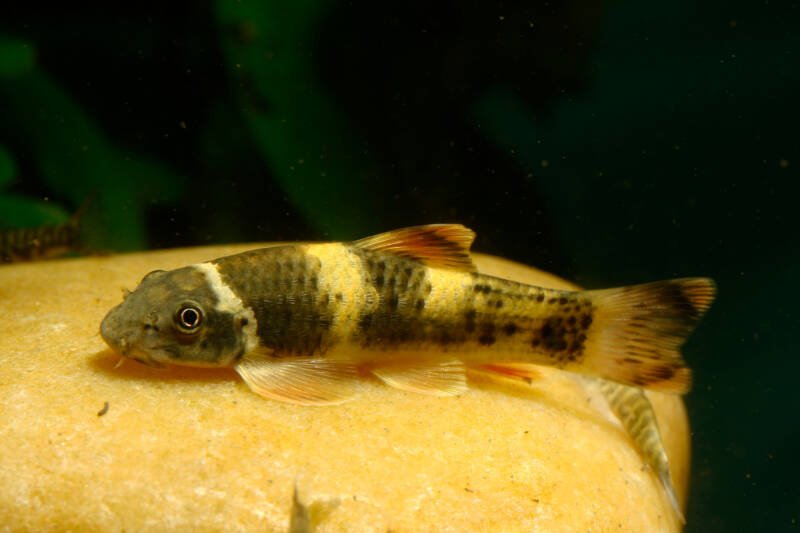
- Difficulty: Easy
- Temperament: Peaceful
- Diet: Omnivore, but needs mostly vegetable foods
- Tank Size: 20 gal (76 l)
The panda garra has deep brown patches interspersed with areas of subtle yellow/gold. Their adult length of 3.5 inches (9 cm) is manageable in a 20-gallon tank.
They are quite active, especially when kept in groups of five or more. However, they do not need the company of their own kind and can be kept as a single specimen.
They have a curious, playful nature and will interact with their keepers. This Myanmar native is hardy and tolerates a wide range of water conditions.
Interestingly, these fish have adapted a suction disc on their lower lip to help hold them in place when in fast-moving waters.
20. Zipper Kuhli Loach (Pangio cuneovirgata)
- Difficulty: Moderate
- Temperament: Peaceful
- Diet: Omnivore
- Tank Size: 20 gal (76 l)
This fish is one of several “banded” loaches in the Pangio genus. Often listed as simply “kuhli loach,” the “zipper” nomenclature is certainly descriptive.
Long, thin, and overlayed with black, saddle-like markings, this smaller kuhli measures 1.5 to two inches (4 to 5 cm) – perfect for small aquariums. Cycle the water well before introducing your loach.
They have delicate skin, so use a sandy substrate. Gravel can damage the skin when this species burrows beneath the sand.
Keep this curious and social fish in a group no smaller than three, although more is better. They are difficult to breed in a home aquarium setting.
21. Kuhli Loach (Pangio kuhli)
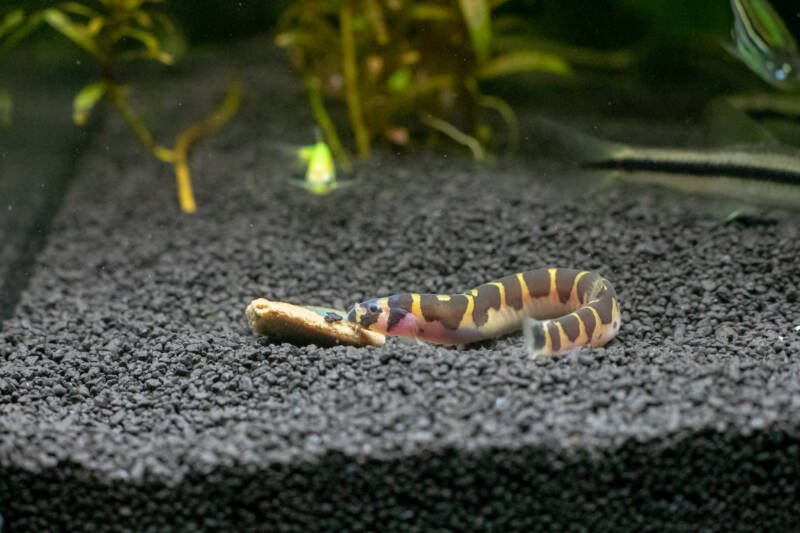
- Difficulty: Moderate
- Temperament: Peaceful
- Diet: Omnivore
- Tank Size: 20 gal (76 l)
The kuhli loach is one of the larger in the Pangio genus, reaching from three to 4.5 inches (7 to 11 cm).
Keep this fish in well-oxygenated water with a decent flow rate and plenty of floor space. They can jump, so keep that lid on tight.
They are highly active at night, and an LED or moonlight feature will allow you to enjoy their playfulness. During the day, smooth-sided hiding places will keep them comfortable.
These peaceful fish get along with other tank mates but cannot withstand bullying by aggressive species. With excellent care, these fish can have a lifespan of up to 10 years.
22. Striped Raphael Catfish (Platydoras armatulus)
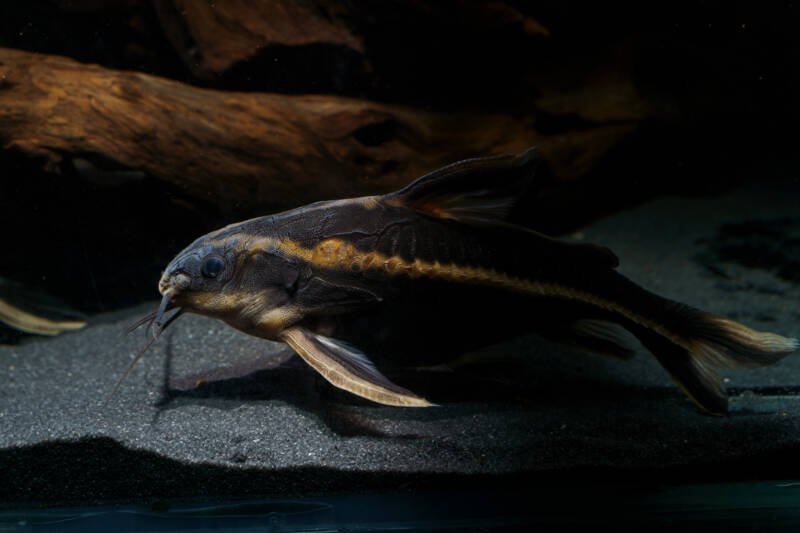
- Difficulty: Easy
- Temperament: Peaceful
- Diet: Omnivore
- Tank Size: 50 gal (189 l)
This catfish species has bold, horizontal white/yellow, and olive/brown stripes. Watch out for their spiny, rayed fins, especially if you must relocate them.
Note that these big fish reach at least six inches (15 cm) in length and sometimes more. Their size and activity levels necessitate a larger tank.
A typical catfish, they will gobble up uneaten food and detritus. Supplemental feeding is a good idea, but do not overdo it as these fish will easily overeat.
Raphael catfish do not breed well in captivity, so the ones you find for sale are likely taken from the wild.
Hardy and armored, these fish can thrive in your tank for up to 10 years.
23. Dojo Loach (Misgurnus anguillicaudatus)
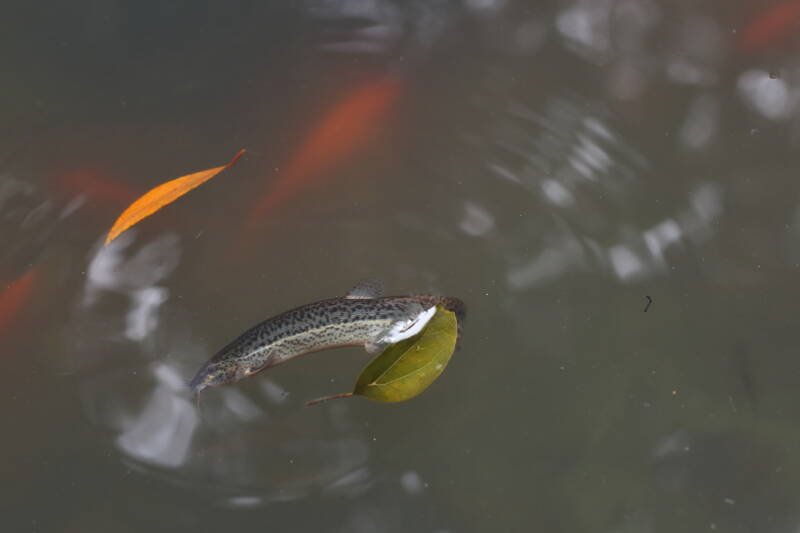
- Difficulty: Easy
- Temperament: Peaceful
- Diet: Omnivore
- Tank Size: 55 gal (208 l)
This fish is also called the weather loach or pond loach. They display a unique behavior in response to dropping barometric pressure. As a storm approaches, these fish swim in an unusual manner.
These eel-shaped fish have a long lifespan that can exceed 10 years.
They have small fins and cute barbels poking out to help in their search for food. Most are subtly colored, but you can find bright, gold-colored variations.
Most stay near six inches (15 cm) in length, but they can reach up to one foot (30 cm).
They tolerate a wide range of temperatures and are excellent for tanks with cold water fish or outdoor ponds.
24. Rainbow Shark (Epalzeorhynchos frenatum)

- Difficulty: Moderate
- Temperament: Semi-aggressive
- Diet: Omnivore
- Tank Size: 50 gal (189 l)
Similar to and often confused with the red tail shark, the rainbow shark has a dark-colored body with red dorsal, pectoral, and caudal fins.
They have a slow growth rate, eventually reaching their adult length of six inches (15 cm). They live an average of six years with diligent care.
These fish can become territorial both with their own kind and other species if kept in too small of a tank. This tendency can increase as they age.
Never place the rainbow shark with other bottom-dwelling species, and always introduce your rainbow shark to the tank last.
Keep either a single specimen or a group of five to spread out aggression.
25. Clown Pleco (Panaque maccus)
- Difficulty: Easy
- Temperament: Peaceful
- Diet: Omnivore
- Tank Size: 20 gal (76 l)
The clown pleco’s appearance draws the eye; their temperament and ease of care seal the deal. They have the downward-turned mouth of a bottom feeder and large, soulful eyes, giving them an endearing look.
Their lower activity levels mean you can get away with a smaller tank for their 3.5-inch (9 cm) length.
Driftwood is essential when planning out tank décor, as are rocky hiding spaces.
While the bulk of their nutrients come from algae, they cannot live on this alone. Throw in some sinking vegetable-based pellets regularly and the occasional meaty treat.
Prepare for a commitment when you purchase a clown pleco, as these hardy fish can live from 10 to 12 years!
26. Blue Dwarf Goby (Stiphodon atropurpureus)
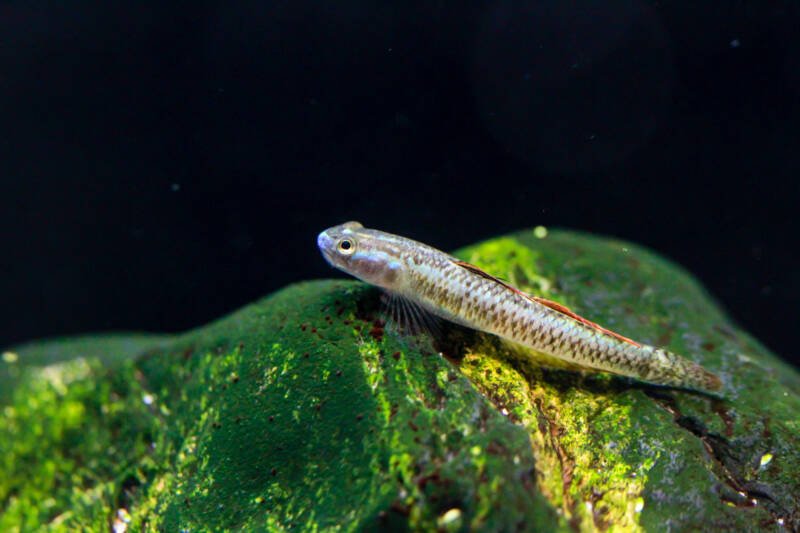
- Difficulty: Easy
- Temperament: Peaceful
- Diet: Mostly herbivore, but can eat some occasional meaty food
- Tank Size: 10 gal (38 l)
Blue dwarf gobies have lovely coloration and gentle temperament, although males occasionally quarrel.
They are a tiny 1.2 to 1.4 inches (3 to 3.6 cm) fully grown and need a strong current in their habitat to mimic their natural environment.
They eat mostly biofilm and algae, although they will accept the occasional meaty treat.
Place these fish in a tank with established algae and biofilm growth. Consider plants, such as Anubias, that can keep this level up.
These fish can be difficult to breed in an aquarium setting. The fry of wild blue dwarf gobies travel swift freshwater currents to marine environments, where they develop before returning to freshwaters.
27. Peacock Eel (Macrognathus siamensis)
- Difficulty: Moderate
- Temperament: Peaceful
- Diet: Carnivore
- Tank Size: 40 gal (151 l)
The peacock eel is long and thin, with subtle dorsal and pectoral fins. They grow to a sizable 12 inches (30.5 cm) in length, so plan on a large tank.
These fish burrow into the substrate and need around four inches of sand to permit this behavior safely.
Natural placement of plants, smooth rocks, and cave structures will complete their environment.
They can be picky with their food, craving meaty foods and not always eager to eat at that.
Peacocks can be territorial with each other, so keep only one per tank. If you care for these fish well, they will accent your tank for upwards of 18 years!
28. Blue Neon Goby (Stiphodon atropurpureus)
- Difficulty: Easy
- Temperament: Peaceful
- Diet: Omnivore
- Tank Size: 10 gal (38 l)
This smaller fish has a bright blue color that makes it the centerpiece of your tank.
These fish are native to fast-moving streams and need a decent water flow in a home aquarium. Their adult length between 1.2 and 1.4 inches (3 to 3.6 cm) means a manageable tank size.
Blue neon gobies feed mostly on algae and biofilm, so make sure the tank is mature and cycled before you introduce them. They will not snack on your aquarium plants.
These fish can live as a single specimen or as a group; however, males may squabble for dominance. Pair blue neon gobies with other small, peaceful species to create a pleasing display.
Closing Thoughts
Bottom-dwelling fish bring activity and beautiful color to the lower levels of your tank. Take care when selecting the proper tank size, decorations, and tank mates to ensure a harmonious environment.
We would love to hear from you! What are your favorite bottom-dwelling species?